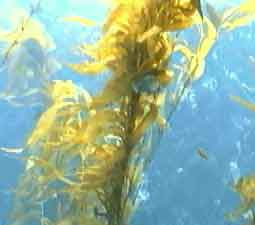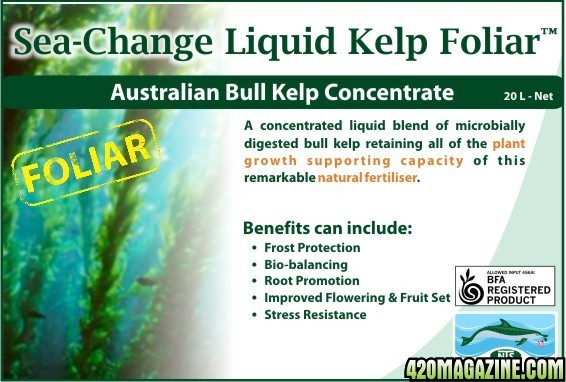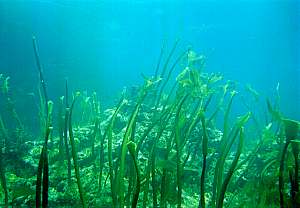Smokin Moose
Fallen Cannabis Warrior & Ex Moderator
I have been using a sea weed tonic on my plants with phenomenal success. I am convinced it has boosted my plants and produced tastier buds. This information explains why it is so beneficial to all growers.

SEA WEED TEA
A truly remarkable phenomenon is that seaweeds grow in the ocean and accumulates potassium but does not accumulate sodium.
The concentration of sodium in sea water is nearly a hundred times the concentration of potassium; yet potassium is accumulated, and sodium is excluded by the seaweed.
Liquid Seaweed is essentially an organic seaweed tea. It is sold as an extract which is diluted with water and applied to the soil, or most effectively used as a foliar spray.
Seaweed has been used by plant growers for centuries, but beneficial results has only recently been attributed to the naturally occurring growth regulators and micronutrients in the seaweed.
After years of research it has been established that seaweeds contain many naturally occurring plant growth regulators, namely cytokinins, gibberellins, and indoles.
In addition, it contains micronutrients such as iron, copper, zinc, molybdenum, boron,manganese, and cobalt.
This is the sea weed tonic I have been using.
 To date more than 60 different types of nutrients have been confirmed.
To date more than 60 different types of nutrients have been confirmed.
However seaweed in itself is not a plant food, rather it is classified as a "bio-stimulant."
Many seaweed products also contain a chelating compound known as mannitol,which chelates micronutrients into forms that are readily available for plant use.
Seaweed contains several chelating agents the most important of which is mannitol.

Seaweed contains natural plant growth regulators.
The major plant growth regulator are auxins, cytokinins, indoles and hormones.
These are in very small quantities generally measured in parts per million.
Seaweed stimulates beneficial soil microbial activity, particularly in soil around the feeder roots resulting in a substantially larger root mass where the beneficial fungi and bacteria known as "mycorrhizae" exist.
This area of the soil is known as the "rhizosphere."
The rhizosphere activity improves the plants ability to form healthier, stronger roots.
Cytokinins are hormones that promote growth by speeding up the process of cell division making seaweed extract of value in treating tissue cultures.
When they are applied to foliage the leaves rejuvenate stimulating photosynthesis.
Auxins, also hormones, occur in the roots and stems during cell division. They move to areas of cell elongation where they allow the walls of cells to stretch.
Auxins actually give fruits and vegetables a naturally longer shelf life.
This is known as delaying senescense: the deterioration of cells and tissues that results in rotting.
Gibberellins are other important plant-growth hormones; more than 50 kinds are known.
They control the elongation of stems, and they cause the germination of some grass seeds by initiating the production of enzymes that break down starch into sugars to nourish the plant embryo.

Hundreds of research reports have been written about seaweed and the micronutrients and growth regulators contained within them.
There are various methods used to identify the individual organic and inorganic compounds present in seaweed.
Without identifying individual compounds, scientists can test for responses in plant material which resemble the responses of plants to known individual compounds, such as cytokinins, auxins and gibberellins, through the use of bio-assays.
Farmers and gardeners should not become too involved in the science of why seaweed produces the results which have been demonstrated over decades of scientific research, field observations, and practical experience.
Rather, they should concentrate on the benefits and results of using seaweed products in their homes, gardens, and fields.
In recent years the results of scientific research provided evidence that seaweeds contain more than 70 microelements and is considerably higher than it is in terrestrial plants.
Plants use tiny amounts of the micronutrients often measured in parts per million.
This helps to explain why foliar spraying can be an effective way to deliver these nutrients to the plant.
Seaweeds are found in all of the oceans except for the tropical western coast of Africa and western Central America.

SEA WEED TEA
A truly remarkable phenomenon is that seaweeds grow in the ocean and accumulates potassium but does not accumulate sodium.
The concentration of sodium in sea water is nearly a hundred times the concentration of potassium; yet potassium is accumulated, and sodium is excluded by the seaweed.
Liquid Seaweed is essentially an organic seaweed tea. It is sold as an extract which is diluted with water and applied to the soil, or most effectively used as a foliar spray.
Seaweed has been used by plant growers for centuries, but beneficial results has only recently been attributed to the naturally occurring growth regulators and micronutrients in the seaweed.
After years of research it has been established that seaweeds contain many naturally occurring plant growth regulators, namely cytokinins, gibberellins, and indoles.
In addition, it contains micronutrients such as iron, copper, zinc, molybdenum, boron,manganese, and cobalt.
This is the sea weed tonic I have been using.

However seaweed in itself is not a plant food, rather it is classified as a "bio-stimulant."
Many seaweed products also contain a chelating compound known as mannitol,which chelates micronutrients into forms that are readily available for plant use.
Seaweed contains several chelating agents the most important of which is mannitol.

Seaweed contains natural plant growth regulators.
The major plant growth regulator are auxins, cytokinins, indoles and hormones.
These are in very small quantities generally measured in parts per million.
Seaweed stimulates beneficial soil microbial activity, particularly in soil around the feeder roots resulting in a substantially larger root mass where the beneficial fungi and bacteria known as "mycorrhizae" exist.
This area of the soil is known as the "rhizosphere."
The rhizosphere activity improves the plants ability to form healthier, stronger roots.
Cytokinins are hormones that promote growth by speeding up the process of cell division making seaweed extract of value in treating tissue cultures.
When they are applied to foliage the leaves rejuvenate stimulating photosynthesis.
Auxins, also hormones, occur in the roots and stems during cell division. They move to areas of cell elongation where they allow the walls of cells to stretch.
Auxins actually give fruits and vegetables a naturally longer shelf life.
This is known as delaying senescense: the deterioration of cells and tissues that results in rotting.
Gibberellins are other important plant-growth hormones; more than 50 kinds are known.
They control the elongation of stems, and they cause the germination of some grass seeds by initiating the production of enzymes that break down starch into sugars to nourish the plant embryo.

Hundreds of research reports have been written about seaweed and the micronutrients and growth regulators contained within them.
There are various methods used to identify the individual organic and inorganic compounds present in seaweed.
Without identifying individual compounds, scientists can test for responses in plant material which resemble the responses of plants to known individual compounds, such as cytokinins, auxins and gibberellins, through the use of bio-assays.
Farmers and gardeners should not become too involved in the science of why seaweed produces the results which have been demonstrated over decades of scientific research, field observations, and practical experience.
Rather, they should concentrate on the benefits and results of using seaweed products in their homes, gardens, and fields.
In recent years the results of scientific research provided evidence that seaweeds contain more than 70 microelements and is considerably higher than it is in terrestrial plants.
Plants use tiny amounts of the micronutrients often measured in parts per million.
This helps to explain why foliar spraying can be an effective way to deliver these nutrients to the plant.
Seaweeds are found in all of the oceans except for the tropical western coast of Africa and western Central America.






 in 7-12 business days my tea will arrive.......early Xmas gift
in 7-12 business days my tea will arrive.......early Xmas gift  With that monster White Widow grow under its belt , sea tea is the real MIRACLE GROW
With that monster White Widow grow under its belt , sea tea is the real MIRACLE GROW